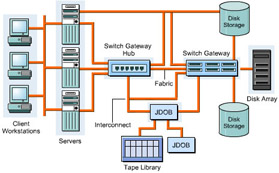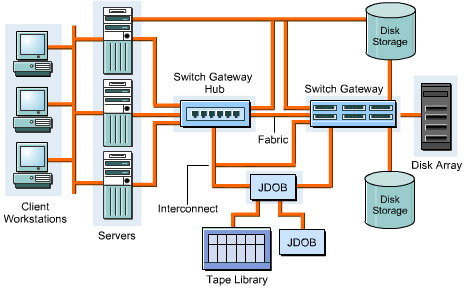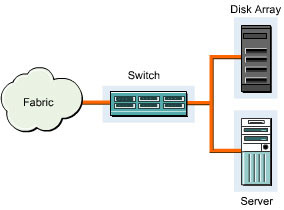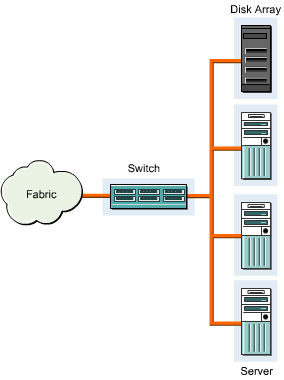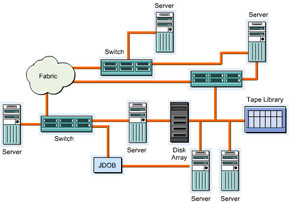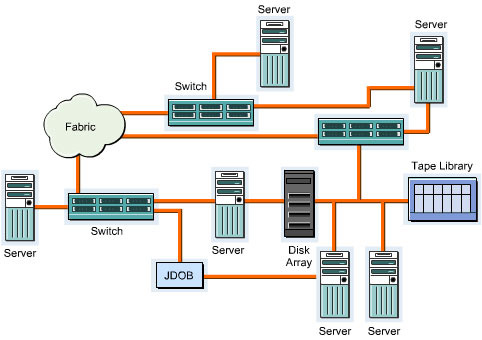A Storage Area Network (SAN) is a high-speed storage network within a LAN. It enables groups of servers to access data in the form of blocks from storage devices. All servers in a SAN have permissions to access the storage resources. A SAN provides concurrent server access on LANs or WANs to all the storage devices. A SAN ensures scalability, reliability, security, low network traffic, improved data availability, and transparent backups and restores.
This ReferencePoint describes the SAN components and the design considerations in implementing a SAN. It also describes the SAN topology and protocols. Finally, it explains the SAN implementation process.
SAN Components
The following devices and components constitute a SAN:
-
Servers
-
Storage Devices
-
Interfaces
-
Interconnects
-
Applications
The SAN architecture depends on the User Interfaces (UIs), interconnects, and fabrics used on the network. This architecture governs the performance of the SAN.
SAN Servers
A SAN supports a heterogeneous server environment and operates on several server platforms, such as UNIX and its versions, Windows NT, Windows 2000, various versions of Novell NetWare, Linux, HP-UX, and Sun Solaris. One of the limitations of the heterogeneous environment is the inability of the servers to share data among themselves because the file systems are different. This limitation is overcome by using data conversion applications that convert data from one file system to another.
SAN Storage Devices
A typical storage device in a SAN stores large amounts of data to avoid the data scattering over multiple storage devices. SAN storage devices are stored outside the primary network, enabling even distribution of storage devices across networks. The following storage devices are used in a SAN:
-
Just a Bunch of Disks (JBOD)
-
Disk arrays
-
Optical storage libraries
-
Tape libraries
-
Disk storage systems
SAN Interfaces
SAN interfaces connect shared storage devices to SAN servers using technologies, such as Fibre Channel. These interfaces facilitate the data storage outside the SAN server. Table 3-1-1 describes several common SAN interfaces:
SAN Interconnects
SAN interconnects connect the interface topologies with the Fibre Channel fabrics. Several of the SAN interconnects, such as cables, adapters, connectors, hubs, routers, multiplexors, and bridges, together form a Fibre Channel fabric.
Fibre and copper cables are the two types of cables that connect SAN components with storage devices. Copper cables are used for distances of up to 30 meters. The two types of fiber cables follow:
-
Multimode fiber cables: Sets the connection over distances ranging up to 2.56 kilometers.
-
Singlemode fiber cables: Sets the connection over distances ranging up to 68.8 kilometers.
Connectors are used to connect fiber-optic devices with copper devices in a SAN network for data transmission. Media Interface Adapters (MIAs) convert fiber-based to copper-based connections.
Adapters act as an interface between SAN interfaces and host buses to facilitate proper communication between them. Host Bus Adapters (HBAs) and Network Interface Cards (NICs) are examples of adapters, which communicate using TCP/IP, FICON, and ESCON protocols.
![]() A hub is a centralized device in a SAN network that connects various SAN devices. A fiber hub can connect up to 120 nodes. Every port on a hub has a Port Bypass Circuit (PBC) that prevents a failed device from affecting other working devices.
A hub is a centralized device in a SAN network that connects various SAN devices. A fiber hub can connect up to 120 nodes. Every port on a hub has a Port Bypass Circuit (PBC) that prevents a failed device from affecting other working devices.
![]() Bridges provide communication across networks using various protocols. They help in connecting SCSI and Fibre Channel interfaces. Multiplexors are bridges that enable the transmission of signals from multiple devices through a single transmission media.
Bridges provide communication across networks using various protocols. They help in connecting SCSI and Fibre Channel interfaces. Multiplexors are bridges that enable the transmission of signals from multiple devices through a single transmission media.
![]() Redundant Array of Inexpensive Disks (RAID) provides an array of storage devices that are fault-tolerant, creating a large virtual drive that reduces the need for multiple drives. Routers transfer data across networks using the addressing schemes and transmission media. For example, storage routers use the Fibre Channel Protocol (FCP) to transfer data across networks. Gateways connect individual LANs over WANs. Switches connect SAN devices with each other but unlike hubs, they do not share the network bandwidth. They pass signals to specific ports and reduce the network traffic. Figure 3-1-1 shows the relationship between various SAN interconnects:
Redundant Array of Inexpensive Disks (RAID) provides an array of storage devices that are fault-tolerant, creating a large virtual drive that reduces the need for multiple drives. Routers transfer data across networks using the addressing schemes and transmission media. For example, storage routers use the Fibre Channel Protocol (FCP) to transfer data across networks. Gateways connect individual LANs over WANs. Switches connect SAN devices with each other but unlike hubs, they do not share the network bandwidth. They pass signals to specific ports and reduce the network traffic. Figure 3-1-1 shows the relationship between various SAN interconnects:
SAN Application Components
SAN application components include the following:
-
Applications to configure and manage the SAN fabric using management software such as:
-
Tivoli SANergy from IBM: Allows simultaneous sharing of the same storage, file systems, and the same files among multiple computers connected to a SAN.
-
Tivoli Storage Network Manager from IBM: Discovers, displays, allocates, monitors, automates, and manages various components of SAN Fabric and disk storage resources.
-
SmartClient from BakBone: Allows network administrators to centrally control the attached media devices.
-
SANworks Enterprise Network Storage Manager and SANworks Storage Resource Manager from Hewlett Packard: Reduces the load on the network server and creates procedures and functions to perform specific network storage and management-related tasks.
-
-
Applications to make regular backups and perform restore operations, volume managers for remote mirroring, disk striping, data replication, and other network management software. Examples of these management applications are the Tivoli Storage Manager from IBM and NetVault Dynamically Shared Drives (DSDs).
-
Applications to share files, folders, and file systems. These applications use zoning and Logical Unit Number (LUN) for masking. For example, the SV Zone Manager from Viacom and SANPoint from Veritas provide centralized management and storage network administration.
SAN Design Methodology
![]() Efficiency of any network depends on the design of the existing network, the components, and the storage systems used. To design and optimize a successful SAN setup, you need to perform the following steps:
Efficiency of any network depends on the design of the existing network, the components, and the storage systems used. To design and optimize a successful SAN setup, you need to perform the following steps:
-
 Assess
Assess -
 Plan
Plan -
 Implement
Implement -
 Manage
Manage
![]() In the Assessing step, information is gathered about the existing network setup and the requirements for designing a SAN. Site auditing collects all the required information to set up a SAN. It is possible to either change the SAN design to adapt to the existing LAN structure, or the existing LAN structure can be changed to accommodate a SAN.
In the Assessing step, information is gathered about the existing network setup and the requirements for designing a SAN. Site auditing collects all the required information to set up a SAN. It is possible to either change the SAN design to adapt to the existing LAN structure, or the existing LAN structure can be changed to accommodate a SAN.
![]() Site audit also helps in sorting out various business and technical issues and helps check SANs compatibility with other systems on the network. It helps in planning decisions and future tasks for designing a SAN. For example, when choosing storage devices for a SAN, their compatibility with the existing network systems is considered. These phases help decide the topology of the SAN setup.
Site audit also helps in sorting out various business and technical issues and helps check SANs compatibility with other systems on the network. It helps in planning decisions and future tasks for designing a SAN. For example, when choosing storage devices for a SAN, their compatibility with the existing network systems is considered. These phases help decide the topology of the SAN setup.
![]() In the Planning step, a decision is made about the devices, network topologies, and protocols to be used for the SAN design and implementation. This step also includes specifying business and technical goals, the quality of service, and the design infrastructure for successful SAN setup. A complete SAN document is created that specifies all the information pertaining to design.
In the Planning step, a decision is made about the devices, network topologies, and protocols to be used for the SAN design and implementation. This step also includes specifying business and technical goals, the quality of service, and the design infrastructure for successful SAN setup. A complete SAN document is created that specifies all the information pertaining to design.
![]() The Implementing step includes the actual setting up of a SAN by going through the detailed document prepared during the planning step.
The Implementing step includes the actual setting up of a SAN by going through the detailed document prepared during the planning step.
![]() The Managing step administers a successful SAN implementation. The step performs all the SAN management and administration tasks that help a SAN function.
The Managing step administers a successful SAN implementation. The step performs all the SAN management and administration tasks that help a SAN function.
 SAN Design Considerations
SAN Design Considerations
![]() A SAN design is customized based on the needs, requirements, and limitations of an organization. While performing SAN customization, you need to evaluate the following:
A SAN design is customized based on the needs, requirements, and limitations of an organization. While performing SAN customization, you need to evaluate the following:
-
 Business requirements
Business requirements -
 Storage pooling
Storage pooling -
 Data availability
Data availability -
 Heterogeneity
Heterogeneity -
 Network performance
Network performance
![]() The priority for implementing any of these considerations varies with different organizations.
The priority for implementing any of these considerations varies with different organizations.
SAN Business Requirements
![]() A SAN can enhance data storage and a retrieval solutions for many enterprise activities:
A SAN can enhance data storage and a retrieval solutions for many enterprise activities:
-
 Enterprise Resource Planning (ERP): Operates on the enterprise resources, such as finance, manufacturing, and product distribution in an organization. ERP requires high transaction speed because it works on critical organizational data.
Enterprise Resource Planning (ERP): Operates on the enterprise resources, such as finance, manufacturing, and product distribution in an organization. ERP requires high transaction speed because it works on critical organizational data. -
 Online Transaction Processing (OLTP): Responds immediately to client queries. Data-processing speed is important for the success of OLTP.
Online Transaction Processing (OLTP): Responds immediately to client queries. Data-processing speed is important for the success of OLTP. -
 E-business and e-commerce: Occurs between business organizations or between an organization and a customer.
E-business and e-commerce: Occurs between business organizations or between an organization and a customer. -
 Data Warehousing: Separates the static data of an organization from the operational data and serves as a data repository for data mining tools. Extracting and storing data that is specific to a business is called data mining.
Data Warehousing: Separates the static data of an organization from the operational data and serves as a data repository for data mining tools. Extracting and storing data that is specific to a business is called data mining.
Storage Pooling
![]() Storage pooling is an important factor when designing a SAN. There are three types of storage pools - Local, Centralized, and Distributed. A local pool provides one-to-one data connection between a storage device and a server and uses the same fabric switch. Figure 3-1-2 shows a local storage pool:
Storage pooling is an important factor when designing a SAN. There are three types of storage pools - Local, Centralized, and Distributed. A local pool provides one-to-one data connection between a storage device and a server and uses the same fabric switch. Figure 3-1-2 shows a local storage pool:
![]() A centralized storage pool provides a one-to-many data connection between multiple servers and the storage system. Figure 3-1-3 shows a centralized storage pool:
A centralized storage pool provides a one-to-many data connection between multiple servers and the storage system. Figure 3-1-3 shows a centralized storage pool:
![]() A distributed storage pool provides a many-to-many connection between multiple servers and storage systems. Figure 3-1-4 shows a distributed storage pool:
A distributed storage pool provides a many-to-many connection between multiple servers and storage systems. Figure 3-1-4 shows a distributed storage pool:
| Note | |
Heterogeneity
![]() SAN supports multi-vendor platforms and operating systems, such as Windows NT, Windows 2000, Linux, Solaris, and Macintosh. The performance of a SAN is judged on how easily SAN integrates with these heterogeneous environments. Before building a SAN, the number of fabric switches and the total number of ports is calculated. When designing a SAN structure, you should keep the future requirements of the organization in mind. The structure should have the flexibility to support new devices without affecting the existing network design and performance.
SAN supports multi-vendor platforms and operating systems, such as Windows NT, Windows 2000, Linux, Solaris, and Macintosh. The performance of a SAN is judged on how easily SAN integrates with these heterogeneous environments. Before building a SAN, the number of fabric switches and the total number of ports is calculated. When designing a SAN structure, you should keep the future requirements of the organization in mind. The structure should have the flexibility to support new devices without affecting the existing network design and performance.
Network Performance
![]() Performance is an important aspect when designing a SAN. Several factors contribute to the performance of a SAN follow:
Performance is an important aspect when designing a SAN. Several factors contribute to the performance of a SAN follow:
-
 Data accessibility
Data accessibility -
 Device connectivity
Device connectivity -
 Network manageability
Network manageability -
 Fault tolerance
Fault tolerance
![]() The physical structure of an existing network is an important consideration when designing a SAN. Proper placement of storage systems with respect to the SAN servers helps in designing a performance-oriented SAN. The physical layout of the network, such as the distance between the storage device and the servers, helps determine the actual cost for setting up a SAN.
The physical structure of an existing network is an important consideration when designing a SAN. Proper placement of storage systems with respect to the SAN servers helps in designing a performance-oriented SAN. The physical layout of the network, such as the distance between the storage device and the servers, helps determine the actual cost for setting up a SAN.
 Storage Environment Selection
Storage Environment Selection
![]() You need to select an appropriate storage device before designing a SAN. For example, Redundant Array of Inexpensive Disks (RAID) provides an array of drives and storage devices that are fault-tolerant and can be used in a SAN design. In RAID, data is stored in several drives. All the levels of RAID provide various performance and redundancy levels. The basic RAID level is RAID 0 and does not offer any redundancy.
You need to select an appropriate storage device before designing a SAN. For example, Redundant Array of Inexpensive Disks (RAID) provides an array of drives and storage devices that are fault-tolerant and can be used in a SAN design. In RAID, data is stored in several drives. All the levels of RAID provide various performance and redundancy levels. The basic RAID level is RAID 0 and does not offer any redundancy.
![]() Redundancy in RAID is provided through virtual disks, ensuring data protection from disk failures. Virtual disks provide high-level fault tolerance and allow damaged disk swapping without affecting network performance. These disks are suitable for heavy database transactions, which are generally levels 3 and 5. Table 3-1-2 lists RAID levels, their descriptions, and use:
Redundancy in RAID is provided through virtual disks, ensuring data protection from disk failures. Virtual disks provide high-level fault tolerance and allow damaged disk swapping without affecting network performance. These disks are suitable for heavy database transactions, which are generally levels 3 and 5. Table 3-1-2 lists RAID levels, their descriptions, and use:
| | | |
|---|---|---|
| | | |
| | | |
| | | |
| | | |
| | | |
 Data Access Using SAN
Data Access Using SAN
![]() In a SAN setup, multiple heterogeneous server platforms can access a storage device simultaneously. Several of the ways to access data from storage devices follow:
In a SAN setup, multiple heterogeneous server platforms can access a storage device simultaneously. Several of the ways to access data from storage devices follow:
-
 Logical Disk Volume Partitioning
Logical Disk Volume Partitioning -
 Physical Disk Volume Partitioning
Physical Disk Volume Partitioning -
 File Pooling
File Pooling -
 Sharing Data
Sharing Data
Logical Disk Volume Partitioning
![]() In logical disk volume partitioning, logical disk volumes are created and assigned to various servers to store data. A logical disk can be stored on a single storage resource or across multiple devices. The storage controller manages the logical volumes and restricts other servers from accessing the disk.
In logical disk volume partitioning, logical disk volumes are created and assigned to various servers to store data. A logical disk can be stored on a single storage resource or across multiple devices. The storage controller manages the logical volumes and restricts other servers from accessing the disk.
Physical Disk Volume Partitioning
![]() The simplest and most commonly used method to access data from a storage resource in a heterogeneous environment is through the physically partitioned storage disk volumes. Every server is assigned an exclusive set of disk volumes using this method. The assigned disk volumes become inaccessible to other servers after they are assigned.
The simplest and most commonly used method to access data from a storage resource in a heterogeneous environment is through the physically partitioned storage disk volumes. Every server is assigned an exclusive set of disk volumes using this method. The assigned disk volumes become inaccessible to other servers after they are assigned.
File Pooling
![]() In the file pooling data access method, a mountable namespace, instead of a disk space, is assigned to a server. Namespace enables a partition set to add or remove file sets even if the server is running. The size of the namespace varies depending on the size of the data file being accessed.
In the file pooling data access method, a mountable namespace, instead of a disk space, is assigned to a server. Namespace enables a partition set to add or remove file sets even if the server is running. The size of the namespace varies depending on the size of the data file being accessed.
![]() The mountable space is released after the server accesses the files. All other servers can then use this disk space to access files. The namespace has the advantage of enabling various file systems to share the same storage space and add a large number of hard drives.
The mountable space is released after the server accesses the files. All other servers can then use this disk space to access files. The namespace has the advantage of enabling various file systems to share the same storage space and add a large number of hard drives.
Sharing Data
![]() The sharing data method enables data access in two ways:
The sharing data method enables data access in two ways:
-
 Sharing data copy: Allows the server to copy the data. After a file is copied to the server, it is updated at regular intervals whenever the file changes.
Sharing data copy: Allows the server to copy the data. After a file is copied to the server, it is updated at regular intervals whenever the file changes. -
True data sharing: Allows simultaneous data access to multiple servers. The three ways by which a server can access data are:
-
One-at-a-time access method: Allows sequential data access to servers on a first come-first served basis.
-
Multiple read access method: Allows the requesting servers to read data simultaneously. Updates are performed one at a time using this access method.
-
Multiple read/write method: Allows simultaneous reading and data updates by the servers. The limitation of this access method is that it can lead to data conflicts due to simultaneous
-

